As a contributor to this publication, I continuously find the most rewarding articles to produce are often those born out of happenstance. Whether it was the piece on BOTL Montreal or local artist Kal Gajoum, there is an excitement to a topic “finding you” through a mere chance encounter in your own cigar community. When this happens it’s an affirmation of the puro’s incredible capacity to facilitate conversation. Beyond just striking up a conversation about our shared passion with a stranger over a few drinks, occasionally you discover the most exciting and unexpected activity happening in your own backyard. Incidentally, unexpected and exciting are the perfect adjectives to describe Alex Nowogrodzka’s project “BenchWorks Cigars”.
The impressive story of Alex’s one-man cigar operation, is born of pure unadulterated passion for the leaf. Just smoking the cigars wasn’t enough, the tobacco hid a secret that enticed Nowogrodzka for further investigation. Around five years ago, during his time working at Toronto’s “Smokin’ Cigar” a chance encounter with a visiting Cuban torcedor would spark the man’s insatiable appetite for cigar making. A foregone conclusion, rolling was the perfect art, and tobacco the ultimate canvas in reconciling Alex’s existing knowledge of cigars with a long-standing creative impulse yearning for new projects.
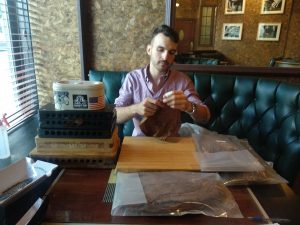
An autodidact in every sense of the word, Nowogrodzka taught himself the delicate art of cigar rolling, transcending the geographic, cultural and familial limitations that traditionally determine accessibility to this skill. For Alex, a natural curiosity and epicurean love of fine foods and wine, appeared to guide his way to the world of tobacco, and cigar making. Gastronomic allegory was never far from his mind when describing his passion.
Behind his humble demeanor, lies a near encyclopaedic knowledge of tobacco, with the 27- year old perfecting his art with every spare minute available to him. Rolling three cigars freehand during the course of our interview, there is no doubting a natural talent to his tactile mastery of the leaves. In a remarkable twist of irony Alex’s birthday falls on the WHO’s “No-Tobacco day”. Yet Nowogrodzka’s mission for Benchworks and the Torcedero tradition are clear as ever. “My goal is to keep carrying the torch and keep the culture alive” . If anyone can be said to live by the leaf, it’s the Torcedor of Montreal, Alex Nowogrodzka.
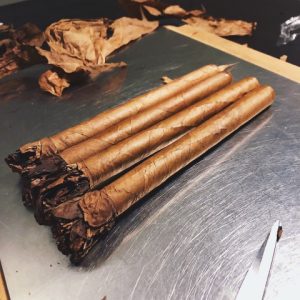
Over the accompaniment of some Romeo Cazadores, and his own Benchworks’ custom rolls, we interviewed at Montreal’s Whisky Café, too engrossed to pay mind to the looming province wide lockdown awaiting the next morning. Alex touched upon his earliest memories of the cigar, the mentors and influencers that shaped his unlikely path, peppered with original insights on the joie de vivre of our hobby and the art of rolling.
Danilo: Do you recall your earliest memories of the cigar?
Alex N: As soon as I saw a cigar as a kid, I was attracted by it. I don’t know if it was me trying to claim my manhood, wanting to become a grown up, or its style. One thing I can say is, I watched Flipper as a kid, and there was a cigar smoking character! I remember thinking it was really cool. Obviously, it was very superficial at first. The memory of the aroma might reveal something deeper. As an 8- year old I stole one from my mom that she had brought from recent trip, surprisingly I didn’t get sick that first time.
Danilo: Do you remember your first cigar, or the first one that really made an impression?
Alex N: My friend had just turned 18, I was 16. I convinced him to get me one, and it ended up being the Don Tomas Natural in a Corona size. There was just so much flavour and complexity, and with my love of food, from that point I would spend any extra money on cigars. I always had an artistic outlet, music, graffiti, photography. At some point the art became frustrating to me because I’m more reactive in my creativity, it was hard to make something out of nothing. Later , cigars became that inspiration to me. When you get a leaf it talks to you, you play it by ear in making something. For instance, these leaves are peppery, what if I add some chocolatiness to it, you know. I had a starting point and it was really comforting creatively so I stopped doing all the other art and started making cigars.
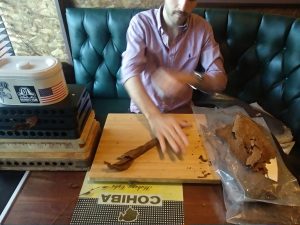
Danilo: If you were to pick up a Don Tomas Natural today, the first one you vividly remember…
Alex N: The blend changed, my palate as well, but I’m very sure because the color changed and the strength was completely different, that’s a big factor…
Danilo: Often what’s forgotten it’s an agricultural product, so it’s going to vary all the time, and therein lies the excitement. There are a lot of variables…
Alex N: When you grow tobacco, it’s kind of like growing tomatoes, there are ugly ones, pretty , fat, and skinnier ones. Same thing with tobacco, the uglier leaves go inside, and the more you go on the outside, the prettier the leaf. The reason there is Seco, Viso and Ligero is because the leaves on the bottom don’t get enough sun as the leaves on the top, so they grow differently . Some are thinner, some are thicker, if you make a cigar with too much of one and not enough of the other, it’s out of balance. So you really have to use the whole plant to create balance between the ugly and the pretty stuff. But what goes inside is the biggest art.
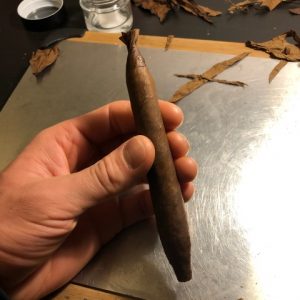
Danilo: And the flavor on each part of the stalk is different…
Alex N: If you want to talk about the anatomy of the plant and not just the cigar, the leaves shoot out, the first leaves at the bottom. As the other leaves start to come in, the leaves at the bottom start losing nutrients to feed the new leaves. You end up with tobacco that burns a little better at the bottom because it is thinner, and you have the tobacco that has much more flavor in the middle. From the bottom you have combustibility, then flavor and just strength at the top. But that’s not a precise science. Sometimes you have leaves at the bottom that are thicker than the middle. As Cesar Alvarez from Tabacalera El Puente would say, “It always depends”.
Danilo: What do you say about the common belief that Maduro wrappers provide stronger flavors?
Alex N: It depends because Maduro is a color grade, a lot of people take it as a process. You can get a leaf to be dark just because it’s grown with a seed that creates a darker pigment. It can also be part of the top of the plant that gets more sun and these leaves come out dark, so they end up with this color without needing a lot of fermentation, and those would be strong. But there are other leaves like the Connecticut Broadleaf or San Andres Negro that are the classic maduros. Since those naturally grow thicker leaves, you can push their fermentation longer. If there are any cabinets that say Maduro, chances are it’s going to be one of these two.
It’s a lot like roasting coffee: A lot of people think the longer the roast the stronger the coffee, but it’s actually the contrary. The more heat you apply to something, the more it loses its strength, its intensity. So Maduros are actually more mellow as tobaccos. The exceptions are those leaves that come from very specific parts of the plant with very specific seeds, that are very dark, not from a Maduro process, but just by colour grade. So, none of the answers are right… it’s what the Maduro wrapper is that determines whether it’s strong or not.
The thing is that people buy with their eyes and even eat with their eyes. When you look at a dark cigar, it’s intensity of look makes you think of strength. So, cigarmakers match the expectation by putting these wrappers on strong blends. But if you were to smoke an old school Maduro, for example, one made by the Fuente family, it’s mellow, sweet, delicious. Once again “it always depends”.
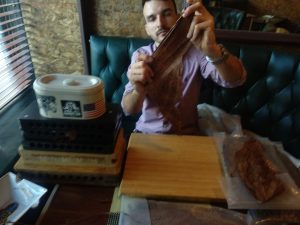
Danilo: Tell me about the moment you decided to take up cigar rolling.
Alex N: I worked at the Smokin’ Cigar in Toronto, I learnt a lot from the owner Trae Zammit, he’s still one of my mentors when it comes to business, period. He’s been in the game for a long time. While I was there a lot of what I was doing was sales, so I learnt that part of the business, but I was looking to learn about the creative part. There was an event that we organized for one of the cigar distributors and they got a Cuban roller, Crissanto to come in. He would sit there and make cigars, bringing sales to the shop, and the sales rep would promote some of their brands…. At this point I was already thinking about rolling cigars, and at the end of my shift, he let me attempt to roll him a cigar. It was the first time I touched a loose tobacco leaf in my life, and he was like “Wow, you have a talent for this”. I said thank you and immediately started to ask him questions in Spanish, and I could barely speak Spanish. He was a bit stubborn but he did compliment my rolling, so I thought “I can do this”. So, I found out where I could get some leaf. From that point I started. Now I’d say I’ve been rolling for 4 years now.
Danilo: That’s incredible, because one would assume its very specific knowledge that’s mostly passed down through the generations…
Alex N: Anything is available online if you dig hard enough. The most helpful were interviews with cigar makers. As much as they may be doing a sales pitch, their love for the tobacco really comes through. Cigar Aficionado has excellent articles about cigar making. And I’m always learning. I started off with blending, later came making them beautiful too and getting into the whole art of it. If I’m not making cigars, I’m reading about cigars. If I’m not reading about cigars, I’m watching interviews with cigar makers. I’m crazy about it.
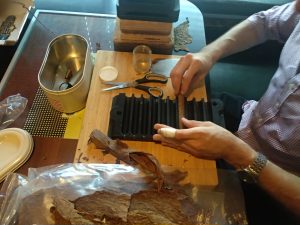
Danilo: Is there a vitola you like making more than others?
Alex N: Because it’s easier, a Rothschild. You can’t mess up a Rothschild, the short robusto, 50 X 114mm. It’s my favorite to smoke, if I’m blending, I’ll always make one.
Danilo: What was that initial period like getting your hands on all the equipment, and starting to teach yourself to roll?
Alex N: The big problem was making money to pay for the stuff. I was broke at the time, very much still an apprentice in construction, I was busting my ass and found a way to the tobacco. I first bought a bunch of small samples, and started smoking it solo. After I started putting it together. I had this stupid cutting board from my kitchen and I would cut the leaves with a pizza slicer. I would get mad because the cigars would look like shit, coming back from a shift from construction completely exhausted. When the leaf would rip, and I would yell…my girlfriend remembers all that but she’s always supported me.
Just to physically make them was a lot of practice. Practice, patience and finding the energy to stay motivated.
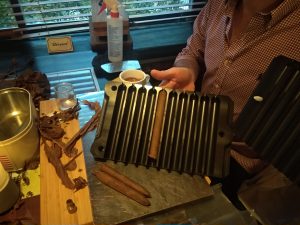
Danilo; It must’ve been difficult coming home and switching gears from such a labor-intensive occupation, to something requiring such delicate movements…
Alex N: The thing is when it comes to bunching and wrapping a cigar, these two things are super different. In the factory you’ll generally see a man bunching and a lady rolling, and wrapping the cigar, but I had to do both. At first, I was doing mostly bunching and really bad wrapping because my first step was getting the tobacco together. As I got better, the wrapping got instinctive, because passing a wrapper is a fairly similar process no matter what leaf you put on. You always have to pay attention when you’re bunching. For instance, if I take a single leaf, just the position where I place it, can mean a totally different cigar. It might be very spicy at the beginning but not at the end… So, you really have to pay attention no matter what, both rollers and bunchers. Every day the tobacco comes, every day it’s different. It may be a bit thicker one day, and the buncher may have to lift his hand to the tobacco manager and say “this viso here, it’s almost like a ligero today so let’s be careful and adjust the blend for it.”
Danilo: Has your relationship with cigars changed ever since you started rolling, has it changed the way you enjoy them?
Alex N: There was this documentary about cigars and Don Pepin Garcia of My Father Cigars was featured in the film. He was asked “can you ever have a cigar and not evaluate it?” i.e.: examine its construction, appearance, blend, and he said “No, I’m always evaluating a cigar whether it’s mine or someone else’s”. And I thought “wow, that’s what I do now!”. I didn’t realize it at first, I don’t smoke for the pleasure of just the pleasure, but rather for the pleasure of curiosity, that’s the reason I love cigars so much, curiosity. And with cigars, you never stop learning.
Everyday I’m smoking my own blends…It’s just like a chef will taste his ingredients all the time…you’re always monitoring your ingredients, and when you take a sip of the soup and it’s good, that’s it.
Danilo: It’s impressive that you established your practice before ever setting foot in the Caribbean. Tell me about your trip?
Alex N: Money was one factor why it took a while to get there, I was still young, working as an apprentice, and living in Toronto was very expensive. As soon as I got enough cash I went down to the Dominican Republic. Thank god for Trae Zammit for making me meet a lot of people when I was working at the shop; reps for different brands, brand owners plus others…these were all my contacts. By the time I was ready for the trip, I already spoke a bit of Spanish, and already knew about tobacco and how to roll cigars, and everyone reacted “who is this crazy gringo how does he know all of that!”. I didn’t spend a single day at the beach. I landed at Puerto Plata, took a cab through the mountains, to Santiago. Eat, sleep, tobacco. The locals were pretty hospitable, they truly live the tobacco.
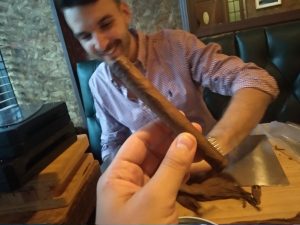
Danilo: Were you always interested in starting your own cigar brand?
Alex N: It’s complicated, but all I can say is that I want to contribute to the industry. I don’t need to have an exact destination, but knowing that I’m moving towards that is what counts. Tobacco is a very cash heavy business, the moment you put in money and the moment you take money out…it’s a long process, margins are smaller, regulations much bigger, so it’s very, very, very hard. I’m looking at the best options for me, what I can add to the industry.
Danilo: Tell me about your one-man operation, BENCHWORKS cigars, how did the branding come to be?
Alex N: Some brand owners work alongside factories and essentially market a ready-made blend, but all my greatest heroes of the industry are more hands-on, so my mentality comes from the bench. BENCHWORKS, meaning that I would have my hands on the bench creating the cigar. That’s what it’s all about.
Danilo: How would you describe the particularities of your brand? You mentioned your cigars fall in the medium to full bodied range…
Alex N: If I had a cigar factory, and I was making cigars for a client, all I would care about is that a cigar is balanced and flavorful…If you have aroma and flavor, I’m happy, I don’t care if it’s a lighter or stronger cigar… If it’s out of balance, it’s just bad cigar making. You can make a tasty cigar with subpar aroma, but it’s flavourful cigars with great aroma that really stick out. If you can manage this, you’re a cigar maker and a half, because the two elements are often in conflict when you’re blending them.
Danilo: Aroma must be a difficult variable to pin down…
Alex N: If you have good tobacco, you’re more likely to set yourself up for good aroma. Certain tobaccos are known to have a nice room note like Olor from the Dominican Republic. Olor means smell in Spanish, hence its name. First of all, when they say that Cuban cigars smell so good, it’s because of the good terroir. Secondly, Skip Martin from Roma Craft believes that when cigars are made exclusively from one country, there is a symbiosis. When we’d walk into a lounge with exclusively Cuban cigars, like La Casa del Habano, it would smell so good because the smoke and the aroma all come from a single terroir. If you had one guy was smoking a LFD, I was smoking an AJ Fernandez, and you were smoking an ADVentura…all these tobaccos, whether it be Honduran, Nicaraguan or Dominican are going to fight with each other in the room.
Going to La Casa, it felt like travelling, it felt like Cuba. I couldn’t believe it but it was set to close on my birthday, May 31st! Do you know what May 31st is? The international day against tobacco!
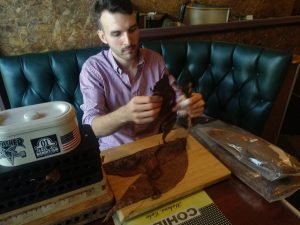


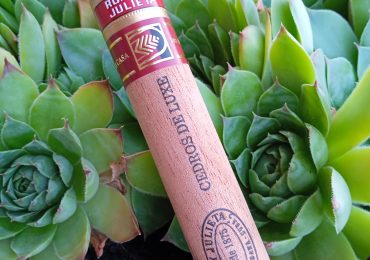
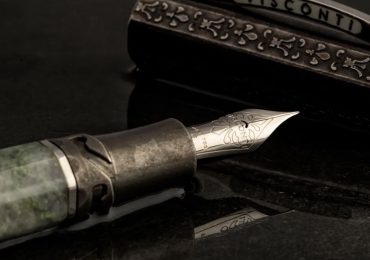
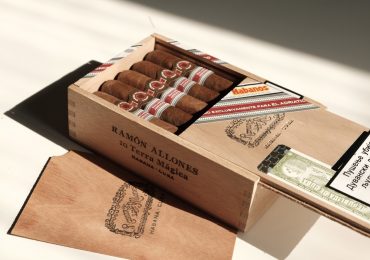
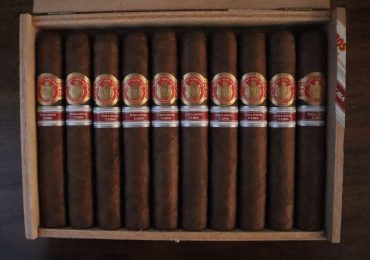
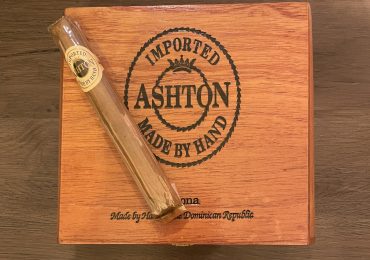
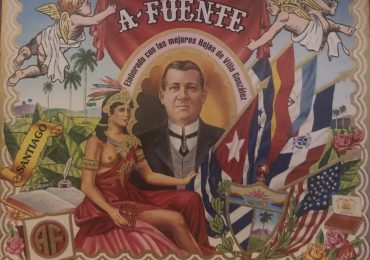
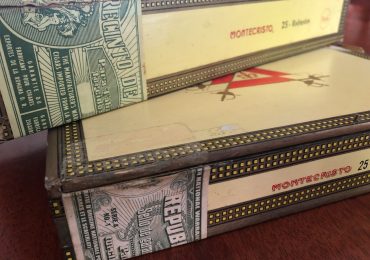
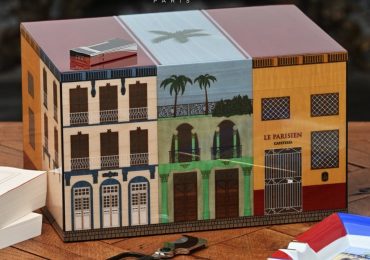
Fantastic article and story, love to see where he is in another four years
thank you! yes will be interesting to see…
thank you. yes indeed, we hope to be able to have an event with him at some point. May we add you to our mailing list?
Im available for any questions you have. You can direct message me on my instagram @benchworks_cigars .
Alex